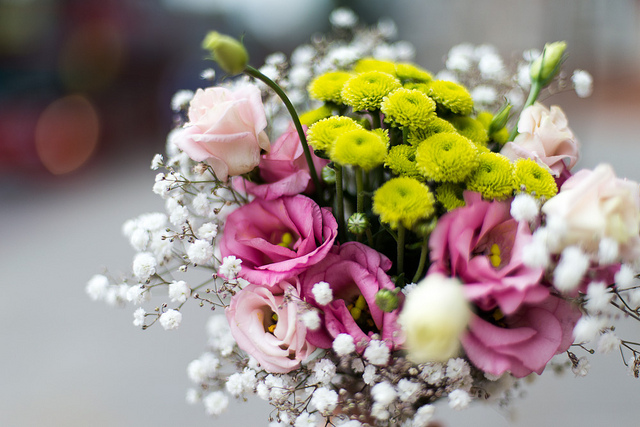Flowers. They are the centerpiece (literally) of most weddings. From bridal bouquets to flower girl accessories to reception and ceremony décor, chances are that if you’re getting married you’re also buying flowers. In fact, the recommended amount that a bride-to-be should budget for flowers is ten percent of her total wedding budget. For today, we’re going to ignore the consumer-machine implications of the idea that there’s a set amount of a budget that a bride is expected to spend on flowers (sort of). We’re instead going to focus on making responsible decisions about how much to spend and on what if you want to be both as postconsumer-friendly and as eco-friendly as you can be.
Throw that 10% Number Out of the Window
To begin with, throw that ten percent number out of the window and instead set what you consider a reasonable amount of money is (and that decision will be personal and different for everybody). If you only want to spend $100 on flowers, then that’s all you should spend. We think that, beyond not wanting to get eaten up by the expectations of the wedding consumer machine, setting hard budgets at the beginning of your wedding planning is important. The wedding consumer machine is a well-oiled piece of equipment and you will be pressured to spend, spend, spend and buy, buy, buy all through your planning process.
Now, Decide What Flowers Are Wasteful
Before you even read the rest of this paragraph, understand that we think that just because you’ve identified certain flowers as wasteful it doesn’t mean you shouldn’t get them if you have your heart set on them. Every individual needs to find his or her own comfort level on the Postconsumer scale, and that includes wedding purchases and budgets. But a good exercise when you’re figuring out what to include or not include in your flower purchases is identifying what’s truly wasteful. For example, we know one bride who recently decided that bridesmaids bouquets were a waste. They would look lovely in the pictures, but ultimately she knew her bridesmaids would just put them down on the table after the wedding and during the reception and never pick them up again. So she bypassed them and instead had her bridesmaids carry books. Go through all of the line items of where you want to include flowers in your wedding and figure out if it’s really worth it, brainstorm alternatives and then balance those against what you have your heart set on. In the end, you’ll have a better list to work with.
The Fake Flower Trend
One of the bigger trends among brides-to-be these days is to use fake flowers, particularly when they’re creating their own bouquets instead of paying a florist to do it. In fact, there are entire online businesses that will ship pre-made fake flower bouquets to you. There are a number of reasons why the fake flower trend is becoming popular. Firstly, it gives you greater control over colors that may not exist in nature. Secondly the fake bouquet lasts forever, and lastly, of course, it’s much cheaper than hiring a florist. Again, we want to emphasize that everybody needs to find their own agreeable level on the Postconsumer scale, but we have to also take a strong stance against fake wedding florals. No matter how big the carbon or consumer footprint of purchasing real flowers may be, it is not as big as that of going the fake flower route. As you’re weighing out the pros and cons of various flower solutions, be sure to keep in mind that fake flowers generate a huge eco-footprint. Think more like a boot print. If you can, try to avoid using them.
Finding Locally-Sourced Flowers
Every once in a while, there is that lucky bride with a mother or aunt or brother who has an elaborate backyard garden from which all of her flowers can be sourced. But most brides who want to order flowers are going to have to do so through a professional florist. Keep in mind that many (in some cases most) exotic flowers are going to have to be shipped to a location from a more tropical climate or larger greenhouse grower. That means that even though your flowers are natural and can naturally decompose afterwards you’ve created a huge carbon footprint in travel miles to get them there. In some cases, you can avoid this simply by asking the florist questions about where each type of flower that you want to use comes from. But in an ideal situation you’ll source your flowers from a florist who specializes in local, native or responsibly grown flowers. If you’re lucky enough to live in an area where one of these florists exists (a simple Google search can find them for you), you’ll quickly notice that your flowers are going to be more expensive than those from a “traditional” florist. But we recommend that you stop and ask yourself if, given how much you’re already spending on your budget, it’s not worth it to spend a couple hundred dollars more on your flowers in order to reduce how much footprint your wedding is leaving overall.
Flowers are beautiful and they’re certainly better options than buying more “stuff,” but like everything else in life it’s good to put some thought into your priorities, budget and overall wants before you rush into making a flower decision. Knowledge is power, and understanding the pros and cons of different flower choices can reduce both your eco-impact and your budget.
Did we miss a tip on making responsible decisions about wedding flowers that you want to share with us? If so, just tell us about it on one of the social media channels below.
Facebook | Twitter | Instagram | Tumblr | Pinterest | Google+





